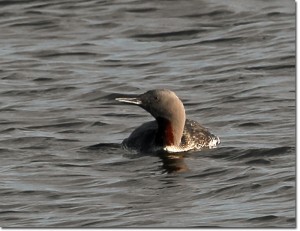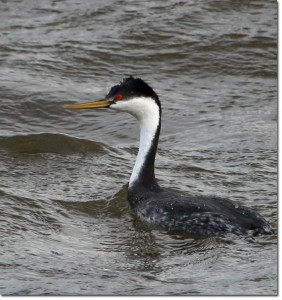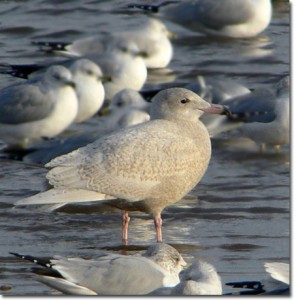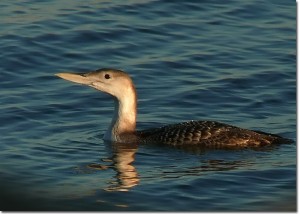by Bill Diffin
Loons — Lake Hefner is a good lake for loons during winter. Common Loons are dependable every year. A few Red-throated Loons have shown up the past two winters, 2011-2012 and 2012-2013. Previous to the last two winters, there were Red-throated Loon sightings in the winters of 1999-2000, 2001-2002 and 2002-2003 (photos on Jim Arterburn’s photo site). Very occasionally a Yellow-billed Loon or Pacific Loon shows up, but they are not seen most years.

There were multiple Yellow-billed Loon sightings on Lake Hefner in the winters of 2008-2009 and 2009-2010 confirmed by photographs. Loons like to fish in the deep water 20 to 50 yards off the rocks along the northern section of the dam. They will also roost in small rafts in that area. They may be seen in other locations also. With a good telescope loons may sometimes be seen 100 yards or more off the big flagpole at Stars and Stripes park in the southeast corner of the lake. It is a good idea to check this location when the wind is very strong out of the south or there is ice rimming the shore. The loon spotting season runs from about November 1 to May 1. Loons will flee the lakes if the amount of ice cover becomes significant. On the other hand ice on the lakes in the states to the north of Oklahoma encourages loons to move south. Those wishing to try for a rare Pacific Loon or Yellow-billed Loon in Oklahoma would be well-advised to check recent sightings particularly for Lake Tenkiller.
Grebes — Lake Hefner is a good lake for grebes during winter. Pied-billed Grebes are year round birds but are much easier to locate in winter when rafts of 20 or more birds are not uncommon. Horned Grebes are dependable from about November 1 to May 1, usually fishing along the dam. There are Western Grebe sightings almost every year at Lake Hefner,

most dependably from mid-October to January 1 and April 7 to mid-May, but occasionally one or two will spend the entire winter season on the lake. Many Western Grebe sightings occur off the southwest end of the dam where Britton Rd intersects W Lake Hefner Dr, however these large grebes are apt to wander widely across the lake. Eared Grebe is a rare visitor to Lake Hefner. If one shows up there, it is likely to be found in the shallow areas around the southwest corner of the lake known as Prairie Dog Point. The lakes in western Oklahoma are better bets for Eared Grebes. Lake Overholser is another good lake for Pied-billed Grebe and Horned Grebe. Like loons, grebes will flee the lakes when the ice cover becomes significant.
Gulls — Lakes Hefner and Overholser are usually good lakes for gulls in winter. Ring-billed Gulls, Herring Gulls and Bonaparte’s Gulls are dependable every year. Franklin’s Gulls are present in very large numbers during the spring and fall migrations. Most winters will see Thayer’s Gulls, Lesser Black-backed Gulls and juvenile Glaucous Gulls on Lake Hefner sporadically and in small numbers. The presence of unusual gulls is encouraged by a low water level which exposes preferred roosting places and food items like stranded fish and mussells. Partial ice cover also encourages the presence of gulls by providing safe roosting and frozen fish. Complete ice cover will send most of the gulls elsewhere. The presence of partial ice cover on the local lakes is an indication of complete freezes farther north which encourages the gulls to move south. Three preferred

roosting spots for gulls at Lake Hefner are: (1) the peninsula extending north from the canal inlet a little east of the southwest corner of the lake, i.e. Prairie Dog Point, (2) the islands off the southeast end of the dam, and (3) the mud flats around Stars and Stripes Park on the southeast corner of the lake, but none of these are exposed when the lake level is high. When there is partial ice cover on Lake Hefner, the gulls will concentrate where the ice is located, usually along the northern sections of the dam. The Lake Hefner Golf Course ponds can be good places to see gulls when there is ice. There is an easily accessible pond a little east of the intersection of Wilshire Blvd and W Lake Hefner Dr. When there is no ice on the lake, large gull species tend to disappear early in the morning when thy fly off to forage at landfills. They return starting mid-afternoon, initially resting on shore at one of the roosting locations already listed. Large numbers of gulls can sometimes be seen around rafts of feeding mergansers. When the wind is out of the south, gulls will soar back and forth along the dam, riding the lifted air currents. As the sun gets low most of the gulls move out into the middle of the lake to roost on the water for the night. When there is ice on the lake, some of the large gulls will stay on the lake all day. At Lake Overholser gulls like to roost during the latter part of the day on the exposed mud flats in the northeast corner of the lake where the river enters, but the mud flats are not exposed when the water level is high. At night they move out into the lake as they do at Hefner. When there has been ice on the lake, it will usually thaw last on the south end and concentrate the gulls there. A Thayer’s, Glaucous or Lesser Black-backed Gull could show up at Hefner or Overholser as early as October, but the peak of the season is typically January 1 to mid-March.

Common Loon — Lake Hefner along the dam, especially the northern sections, October to mid-May.
Red-throated Loon — Lake Hefner along the dam, especially the northern sections, November thru April.
Yellow-billed Loon — Lake Hefner, not present every year, check along the dam.
Pacific Loon — Lake Hefner, very rare, check along the dam. Lake Tenkiller is a better spot for this species.
Horned Grebe — Lake Hefner anywhere along the dam, especially the western section, October thru April.
Western Grebe — Lake Hefner most years, best to look along the dam, especially the southwest end, but could be anywhere, mid-October thru mid-May.
Thayer’s Gull — Lake Hefner on the ice or on exposed islands and peninsulas when the water level is down, January to mid-March. Lake Overholser same dates, especially good viewing if there is ice at the south end near the dam.
Glaucous Gull — Lakes Hefner and Overholser. Not every year. Usually only juveniles. Same times and locations as Thayer’s Gull.
Lesser Black-backed Gull — Lakes Hefner and Overholser. Most years at Lake Hefner. Locations as for Thayer’s Gull. October thru April is possible, but January thru March is more likely.
For more precise date of occurrence information, the on line Migration Database of the Oklahoma Bird Records Committee can be consulted, or their Date Guide to the Occurrence of Birds in Oklahoma booklet can be consulted. However departures from the published norms are somewhat more likely to occur with uncommon species because the data are insufficient to accurately reflect long term behavior. Clues to the occurrence of uncommon species can be garnered from the habits of their common associates.
The movements of Lesser Black-backed Gulls are likely to be very similar to Herring Gulls. Thayer’s Gulls and Glaucous Gulls, both high Arctic breeders, are likely to move south together in winter.
Occurrence dates for the above guidance were provided by the Oklahoma Bird Records Committee, Pat Velte, Jim Arterburn and Bill Diffin.
